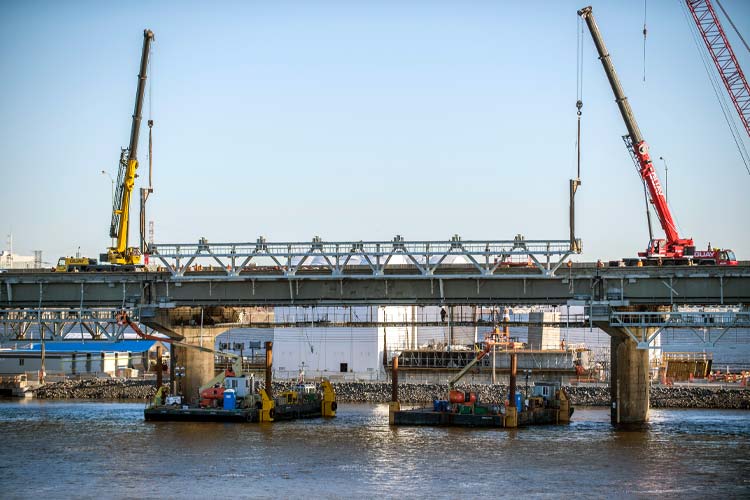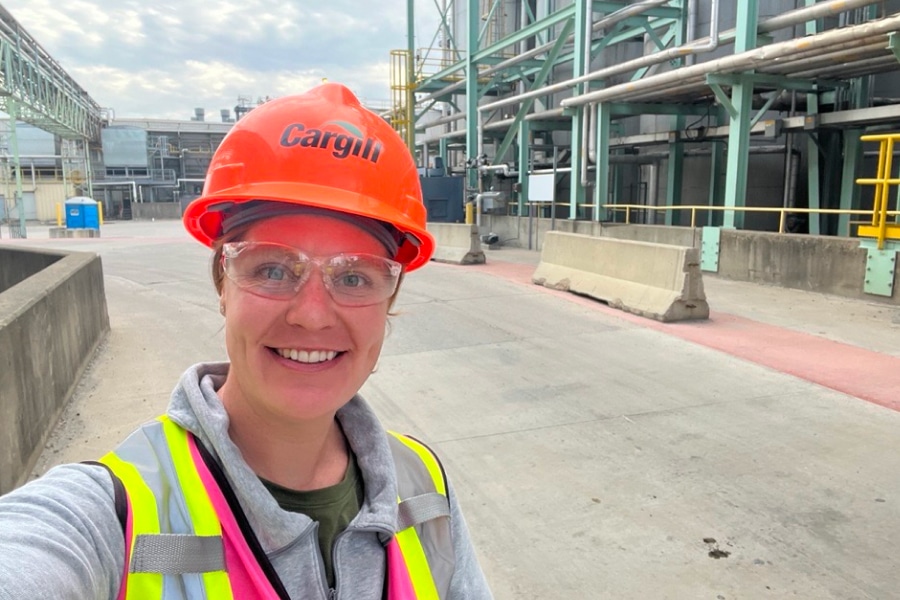When a bridge is meticulously demolished over several years, there isn’t much immediate satisfaction—in the end, all you’ll see is empty space.
But a peek behind the scenes at the challenges faced by the engineers and construction crews tasked with dismantling the Champlain Bridge in Montreal, Quebec, offers an interesting glimpse into a complex project that will be carried out over 43 months.
Inaugurated in 1962 during Canada’s infrastructure boom, the 4.3-mile-long Champlain Bridge sprawled across the St. Lawrence River. The total span—including the 2.1-mile steel structure directly over the water—was unusually long for its time; it was built high enough so that vessels headed to the ocean could pass underneath.
The bridge became Canada’s busiest crossing—some 60 million vehicles traveled its length each year—contributing to increased trade between Eastern Canada and the U.S. and launching Montreal as a major manufacturing hub, according to Dinu Bumbaru, policy director at Heritage Montreal, a nonprofit that promotes and protects the city’s historic and architectural heritage.
“The bridge itself was a celebrated technological achievement for its length and use of pre-stressed concrete beams and deck, plus the additional challenge that came from crossing the mighty St. Lawrence River and its harsh winter ice pack,” Bumbaru said.
A growing danger
But by 2011, the bridge’s declining health was increasingly evident. The bridge’s inadequate drainage system was no match for Quebec’s harsh winter freeze-and-thaw. Excessive use of road salt had wreaked corrosion havoc, and vibrations from trucks tasked the viaduct, resulting in an alarming web of cracks through its massive piers.
Saeed Mizra, a former McGill University structures specialist, described the bridge as having the engineering equivalent of terminal cancer. The Canadian government decided to replace it.
Another CA$500 million to reinforce the steel trusses kept the deteriorating structure standing while the new cable-stayed Champlain Bridge was being built. The structure was inaugurated on June 28, 2019, the same day the old bridge was officially taken out of service.
Scaling up for a take-down
“The deconstruction of the Champlain Bridge is unique due to its sheer scope: It involves 287,000 tons of materials and it’s also an enormous technical challenge for civil engineers because of the deteriorated condition of the bridge and the reinforcements that were added to support it,” said Nathalie Lessard, communications director at the Jacques Cartier and Champlain Bridges Inc. (JCCBI), the federal bridge management corporation.

Last June, JCCBI inked a CA$400-million design-build demolition contract with Nouvel Horizon St-Laurent G.P. (NHSL), a company formed by Pomerleau Inc. and Delsan-A.I.M. Environmental Services Inc. Work to deconstruct the Champlain Bridge will take place over 43 months, ending in January 2024. The demolition, which began in August 2020, is expected to cost CA$225.7 million, with the balance of the budget allocated toward redeveloping the shoreline afterwards. Up to 200 workers will be onsite at once.
As with any demolition job, top-notch engineering is required due to the creation of conditions that might be unsafe or unstable. Sections of steel and reinforced concrete will have to be removed piece by piece, and with each concrete girder removed, there’s the potential to destabilize the structure, so the need for precisely controlled steps is critical, requiring careful planning and execution, Lessard said.
More than two-thirds of the bridge has to be dismantled from the St. Lawrence River, with workers using various platforms affixed to high-capacity lifting towers installed on catamaran barges. The bulk of work is scheduled to take place between 2021-2023.
“There are constraints that don’t allow us to perform work during specific periods,” Lessard said. “For example, we can only work on the portion of the bridge over the St. Lawrence Seaway when it’s closed to boats in January or February. So, if you lose that window, you have to wait a year. Also, there are periods that are sensitive to fish habitats from April through August in some locations.”
The deconstruction of the steel structure over the river—during which a 2,200-ton suspended span will be lowered and removed onto barges using strand jacks—is scheduled to start in the fall of 2021 and run through the winter. Jetties were built for use in areas of the St. Lawrence River where the water is too shallow for barges to work.

Cantilever sections and anchor spans will then be dismantled using cranes set up on jetties. The final stage will see high-capacity excavators deconstructing the bridge piers. The jetties will be removed in early 2024, completing the project.
“The safety of the structure and the workers has guided the choices of the deconstruction methods,” Lessard said. “Plus, there are COVID-19 safety guidelines to follow. Lots of training is being provided by NHSL to the workers.”
A sustainable, R&D-focused approach
This demolition project is also unusual because it’s guided by sustainable priorities, according to Lessard. “We implemented environmental protection measures to minimize the impact over the St. Lawrence River and protect biodiversity,” she said.
“We’re also conducting research and development projects with seven universities during the deconstruction,” Lessard added. “It’s a unique opportunity for researchers to be working on a large-scale structure, and their findings will significantly advance knowledge about infrastructure performance and longevity.”
New life for salvaged bridge materials and public space
Post-deconstruction, JCCBI intends to recycle or reuse 90% of the 250,000 tons of concrete, 25,000 tons of steel and 12,000 tons of asphalt. Most of the steel trusses installed over the past five years to shore up the bridge structure are still in good shape, Lessard said, and ideally the material will be reused as is in other projects and not melted down.
“For example, the city of Montreal is looking to reuse certain steel components of the bridge to build a cycling or pedestrian bridge, and concrete can be reused in all sorts of infrastructure projects,” Lessard said.
Lessard said a competition will likely be launched this year to evaluate project proposals for public art installations or creative ideas to use elements from the bridge. Residents have also provided input about the shoreline redevelopment, Lessard said. About 5,000 people participated in public consultations, suggesting the creation of more walking and bike paths parallel to the new bridge, and more access to the river.
“We want something that’s going to be a testimony of the existence of the old bridge,” Lessard said. “If we can have public art that reuses parts of the bridge, that would be wonderful.”
“Although at the end people were sometimes scared to drive on the Champlain Bridge, it was a huge contribution to Montreal’s social and economic development,” she added. “We want a legacy. We want to pay homage to this bridge.”












